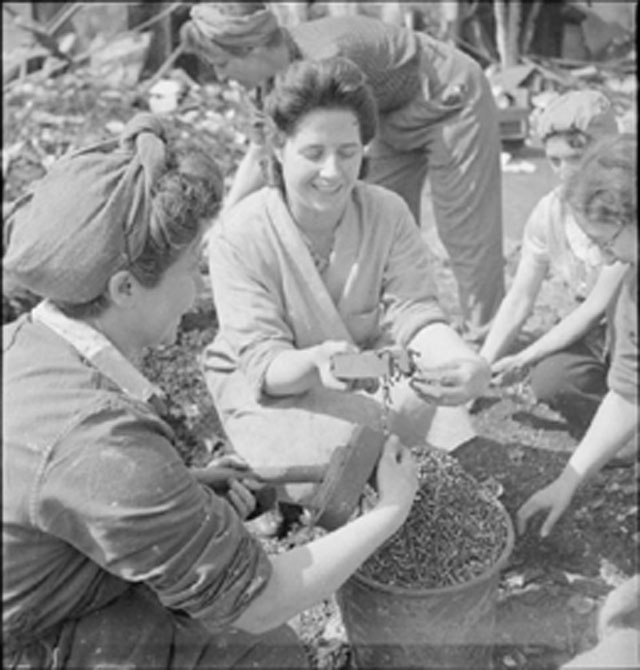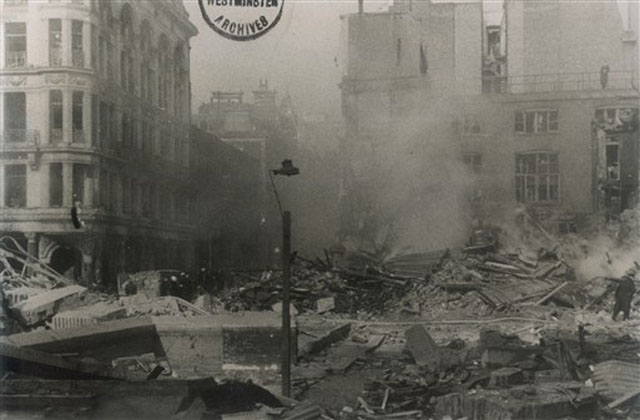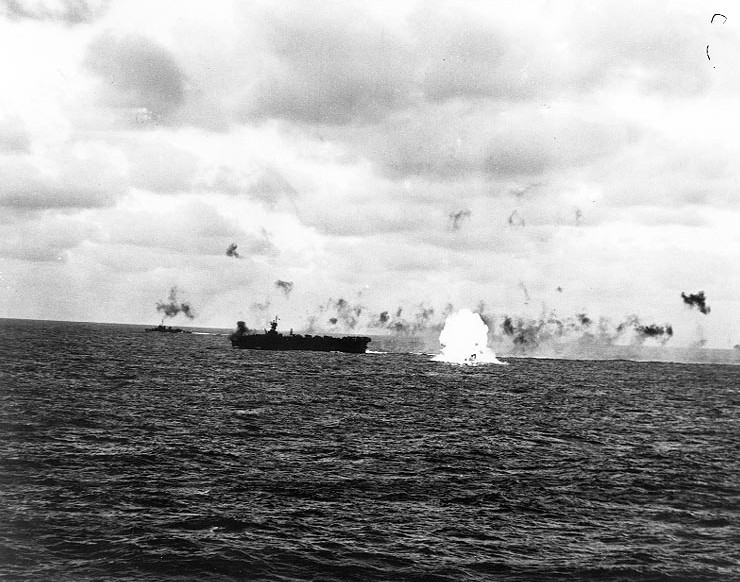Air Operations, Bismarcks
9 42nd Medium Bomb Group B-25s attack Rabaul's Vunakanau airfield. 10 42nd Medium Bomb Group B-25s attack the Keravat airfield at Rabaul. 4 US Navy PVs attack buildings on Cape St. George. 4 XIII Bomber Command B-24s attack Japanese Army bivouacs. XIII Fighter Command P-38 fighter-bombers mount their first dive-bombing mission of the Rabaul campaign, an attack against the Rabaul town area.
[Air Operations, Carolines
VII Bomber Command B-24s attack Kusaie and Ponape islands.
[Air Operations, CBI
BURMA- 14 7th Heavy Bomb Group B-24s attack the airfields at Akyab and Dabaing. 3 490th Medium Bomb Squadron B-25s and 12 10th Air Force P-51s attack a radio station at Man Pang. 4 10th Air Force P-51s attack warehouses at Chantha. 4 14th Air Force P-40s attack the airfield at Lashio.
- 4 341st Medium Bomb Group B-25s attack shipping in the Gulf of Tonkin and rail facilities at Van Trai.
Air Operations, Europe
RAF BOMBER COMMANDEvening Ops:
- 17 Mosquitos are sent to Düsseldorf, there are 2 Serrate patrols and 3 OTU sorties.
- There are no losses.
- A Mosquito of 692 Squadron on the Düsseldorf raid is the first Mosquito to drop a 4,000lb bomb. The Mosquitos of the Light Night Striking Force regularly carry such heavy bombs during the remaining months of the war to targets as far distant as Berlin.
ITALY:
- Almost the entire 12th Air Force is grounded by bad weather, but a small number of XII Air Support Command P-40s able to patrol the Anzio beachhead area and attack gun emplacements near Campoleone.
AUSTRIA:
- 81 15th Air Force B-24s attack an aircraft assembly plant at Steyr, and 21 B-24s demolish much of the Steyr factory responsible for 10 percent of Germany's anti-friction ball-bearing production. Although the bombing results are excellent, the bomber force is attacked over the Alps by an estimated 120 Luftwaffe fighters, and it sustains the 15th Air Forces's worst one-day loss ratio: 17 B-24s downed against just 1 Me-210 downed and 2 Bf-110s damaged by 14th Fighter Group P-38 escort pilots.
Air Operations, Marianas
The crews of 4 VT-25 TBMs down a Ki-49 'Helen' heavy bomber at sea at about 1400 hours.
[Air Operations, Marshalls
VII Bomber Command B-24s attack the Jaluit Atoll. 41st Medium Bomb Group B-25s attack the Taroa airfield on Maloelap. 15th Fighter Group P-40 fighter-bombers attack the Mille Atoll.
[Air Operations, New Guinea
- Nearly 50 V Bomber Command B-24s and A-20s attack the airfield at Wewak and nearby antiaircraft batteries.
- 3 17th Reconnaissance Squadron B-25s orbit at low level over Manus and Los Negros islands for 90 minutes without drawing fire. This leads to speculation regarding a possible Japanese withdrawal from the islands, and so Gen Douglas A. MacArthur orders a ground reconnaissance to be undertaken as soon as possible.
CBI
BURMAThe 65th and 66th regiments of the Chinese 22nd Division occupy Yawngbang, from which the Japanese have already retired.
In the British 14th Army sector, after trying hard but in vain to overcome the resistance of the Indian 7th Division at Sinzweya, the Japanese withdraw. It is the first time the British had defeated the Japanese in battle.
[Eastern Front
In the north the Red Army takes Strugi Krasnyye, midway between Luga and Pskov. It also begins to attack Dno southwest of Lake Ilmen.
[Indian Ocean
The US tanker E. G. Seubert, in Convoy PA-69, is torpedoed and sunk by U-510 about 200 miles from Aden. 3 of the crew and 3 Armed Guard sailors are lost in the explosion. The survivors are rescued by the Australian minesweeper Tamnworth and the Indian Navy corvette Orissa.
[Italy
Gen Lucian K. Truscott, for some time deputy, takes full command of VI Corps at Anzio, replacing Gen John P. Lucas. Somewhat ironically the battle has now settled down to the sort of careful position warfare that Lucas is probably well fitted to control.
The Germans, continuing limited actions, wipes out those elements of the British 56th Division that have replaced the 45th Division in the region west of the Albano road.
[Marianas
(Rear-Adm Mitscher's Task Force?)The carriers of Frederick C. Sherman's TG 58.3 and Alfred E. Montgomery's TG 58.2 attack Rota, Tinian, Guam and Saipan. They sink 20,000 tons of Japanese shipping and a great number of enemy aircraft are destroyed on the ground or in combat.
[Marshalls
The fighting for Parry comes to an end and with it the battle for the whole Eniwetok Atoll. The US losses are 300 dead and 766 wounded. Typically, the Japanese garrison has fought practically to the last man. There are 66 prisoners out of a force of 2,600. Brig-Gen Thomas E. Watson (USMC), the amphibious commander for the Marshalls operation, is unimpressed by the army's performance, an opinion he is more than willing to share. The rapid and unexpected success of the attack on the Marshalls allows Adm Nimitz to advance his planning timetable for the scheduled assault on the Mariana Islands by nearly 12 weeks. The formula for success for amphibious assaults has clearly been validated during the Marshalls operation: heavy volumes of concentratef firepower from artillery, air strikes, and naval gunfire followe3d by an amphibious assault that joint tanks, infantry, demolition and flamethrower teams working together to destroy Japanese defensive positions and move rapidly inland.
[New Britain
More American fighter squadrons arrive at Cape Gloucester.
[Pacific
- The US submarine Balao (SS-285) attacks a Japanese convoy about 35 miles north of Biak, New Guinea and sinks the army cargo ship Nikki Maru (5857t).
- The US submarine Cod (SS-224) sinks the Japanese fleet tanker No.3 Ogura Maru (7350t) off Halmahera.
- The US submarine Plunger (SS-179) attacks a Japanese convoy about 200 miles northwest of Chichi Jima and sinks the transport Kimishima Maru (5193t).
- In an attack on a Japanese convoy about 60 miles west of Okinawa, the US submarine Pogy (SS-266) sinks the merchant cargo ship Horei Maru (5588t) and damages the merchant tanker Teikon Maru.
- Attacking a Japanese convoy about 120 miles north-northwest of Chichi Jima, the US submarine Snook (SS-279) sinks the transport Koyo Maru (5471t).
- In a joint attack by the US submarine Sunfish (SS-281) and planes from the carrier Yorktown (CV-10) sink the Japanese collier Shinyubari Maru (5354t) about 40 miles west of Saipan.
- The US submarine Tang (SS-306) sinks the Japanese repair ship Yamashimo Maru (6776t) west of Saipan. A huge explosion resulted damaging the Tang, but she remains on patrol.
Soviet Union, Home Front
The NKVD begins the mass deportation of Chechens and Ingush from their homelands following Stalin's accusation that they have aided the Germans (who is encouraged in his paranoia by NKVD chief Lavrenti Beria). Some 362,000 Chechens and 134,000 Ingush old men, women and children are rounded up and packed on to 180 train convoys in the space of just over a week. Some 20,000 NKVD Troops are used, most families being given 5-10 minutes to pack up their belongings and food for the trip (no food is supplied). Tens of thousands die during the journeys which last up to two months (bodies are often left in overcrowded cattle wagons for weeks). In sub-zero temperatures, the survivors are dumped in Siberia or on the Kazak steppes. Around half of all those deported will die.
[United States, Home Front
Dr Leo Hendrik Baekeland, Belgian-born inventor of 'bakelite' dies at age 80.
[United States, Planning
Reconnaissance by B-25 Mitchells over the Admiralties shows no signs of activity on Los Negros Island or on Momote airfield. Given this information, MacArthur rejects the assessment of his intelligence chief (confirmed by Ultra intercepts) that the Japanese have over 4,000 men on the island and decides to launch an immediate attack. He termis this a reconnaissance in force. If successful, he intends to press the attack; if unsuccessful, he can recall his forces. MacArthur call his plan 'a gamble in which I have everything to win, little to lose.'
[Images from February 23, 1944
|
|
|
|
|
|
|
|







